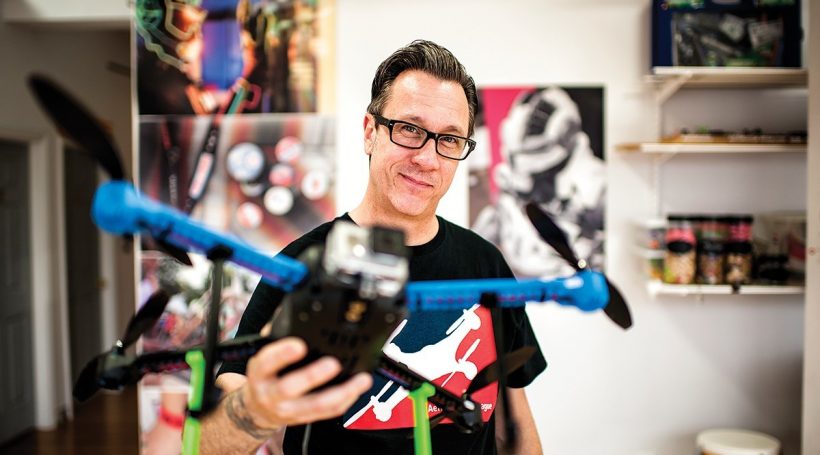The modern home is filled with robots – vacuums, video game consoles, smart TVs, telephones and thermostats. The new car in the garage can think for itself, applying the brakes or parallel parking for you. But the next step in the great march of progress isn’t happening in our homes – it’s happening above them.
The drones are coming. They’re about the size of a laptop computer, outfitted with motors and spinning blades, and powered by remote control or, often, a smartphone app. The Consumer Electronics Association estimates more than 400,000 of the tiny aircraft were shipped to U.S. homes over the holidays. It’s safe to say this won’t be a passing fad.
A growing number of hobbyist drone pilot groups have formed in South Jersey, including the Rotor-E Drone Club, which meets at the SoHa Arts Building in Haddon Township. The building is a maker space – like a community center with tools – where technology, equipment and education allow members to work on projects they might not have the resources to create at home. Usually, the first thing people want to know about drones is exactly what they are, says Lavon Phillips, director of the SoHa Arts Building. Then they want to know where they can get one.
“When we say ‘drone,’ we mean an unmanned aerial vehicle (UAV) with a GPS in it,” says Phillips, who runs the Rotor-E Drone Club. “We’re about technology, robots; have always been the thing we do here. We have drones, and every child and parent who comes in says, ‘Hey, how can I get involved in this?’”
The club hosts regular meet-ups, where a core group of drone pilots, ranging from teens to middle-aged adults, demonstrate their UAVs for hundreds of attendees.
Phillips says the main focus of the SoHa Art’s Building is education. Children who are intrigued by UAVs are invited to take classes in electricity basics, learning to solder and build circuitry in addition to classes in coding, flight dynamics and physics – the necessary components to drone-building.
One of the Rotor-E Drone Club’s regular attendees is Sam Zeloof, 15, a Flemington native who fell in love with drones about a year ago.
“A few years ago, I started building model airplanes and had a lot of fun with those,” Zeloof says. “I also love photography, so it started with wanting to combine my hobbies. Putting a camera on a model airplane wasn’t very feasible, so that’s when I built my first quadcopter [a drone with four propellers].”
Zeloof’s new pursuit quickly turned him from passionate hobbyist to savvy entrepreneur. Footage he’s shot with his drone has aired on the Discovery Channel and elsewhere, and he and business partner Liam Hanna, 18, formed a company called Flying Squirrel Multirotors.
While many hobbyists choose to purchase pre-built drones, they can be expensive. Popular brands range from $400 to upwards of $3,000. Zeloof says another drawback is many pre-built drones aren’t as customizable as the pilot might like. For those who prefer to build their own, Flying Squirrel Multirotors manufactures and sells kits that streamline the building process and make the expensive hobby a bit more reasonable – kits start at just $250.
“I found out pretty quickly it’s not a very kid-friendly hobby in terms of cost,” Zeloof says. “It can get pricey. So we produce a kit that’s easy to assemble, and we do it that way so people learn about the drone while building it. The goal is to make this accessible to everyone.”
Flying Squirrel also produces an educational package specifically designed for use in technology classes. A number of schools in Central and South Jersey have purchased those kits, which include more than an hour of instructional video created by Zeloof.
“Our goal was not just to create a product,” he says. “We want to give everyone the knowledge about how this technology works and what it can do, and the confidence to enjoy it and be creative.”
Drone education is also taking off elsewhere in SJ. The Cherry Hill Library plans to incorporate drone classes into its spring curriculum, and Rutgers and Rowan are among a growing number of universities doing drone-based research or offering courses on UAVs.
Despite the overwhelmingly rapid growth of the drone industry, the technology has its skeptics. The rising popularity of UAVs has sparked concerns over safety, particularly in light of high-profile incidents like drones crashing on the White House lawn and at the U.S. Open, and reported “near-misses” with commercial airliners.
Governments and legal bodies are rushing to regulate drones, calling for increased safety measures and procedures. The Federal Aviation Administration (FAA) recently convened a task force of companies with vested interest in the industry – among them Amazon and Google – to work through the potential regulations. Ultimately, the task force’s recommendations were vague; they called for owners to enter their UAVs in a national database and display a government-issued registration number on each machine.
The FAA also created a smartphone app called B4UFLY, designed to help hobbyist UAV users ensure they’re in a safe location to operate their drones. To date, the app has been released to a few hundred beta testers, among them the more than 200 members of Haddonfield’s Rotor-E Drone Club.
“The more it’s in the news, the more people want to know about it. We started our group so people know the current laws and they have a safe place to come to enjoy the sport of droning,” Phillips says. “The app isn’t available in stores, but we get to test it and play with it. As soon as you open the app it says, ‘Safety is everyone’s responsibility.’ It tells you if it’s legal to fly where you are and how close you are to an airport, power lines and nuclear facilities.”
On a local level, towns have begun governing drone use, like the Ocean City ordinance that bans the use of drones within five miles of the Ocean City Airport. That ordinance has a sunset provision – it will expire in September of this year – but in the meantime the council has formed a committee to better understand drones and their accompanying issues.
Proposed legislation doesn’t apply only to hobbyist drone pilots. Last spring, the New Jersey Assembly passed a bill with bipartisan support that would require law-enforcement agencies to obtain a warrant before using a drone as part of an investigation and prevent them from being equipped with weapons. The Senate has yet to vote on that bill. While he hasn’t spoken about the new bill publicly, Gov. Christie pocket-vetoed a similar measure in 2014.
In the absence of federal, state or local regulations, law-enforcement agencies are left to create their own drone-use guidelines. Last year, Camden County became the first in the state to purchase a UAV when it spent $3,400 on a drone equipped with a camera for use at the county correctional facility.
“The Board of Freeholders purchased the drone, based on a need identified by our law enforcement,” says county spokesman Dan Keashen. “The warden reached out and said he thought a drone would be a great resource for any emergency management situation that may take place at a jail. We’re doing research on other prisons and jails that have implemented this tool, and we’re currently taking those best practices to create our policies and procedures with the drone.”
“Today we use robots for our tactical team and our bomb squad. We use them for hostage situations. The drone is just one more tool we’ll be adding,” Keashen says. “As of now, I’m not sure the need’s been identified for front-line policing. We’ll have to see how the applications evolve over time. They could change pretty dramatically in just a year or two years.”
As far as Phillips is concerned, the applications are endless. Though today the primary use of most hobby drones is either photography or racing (a fledgling sport with a professional league, major funding and a growing fan base), he’s constantly seeing UAVs used to fill more diverse job descriptions.
“They’re being used to monitor crops all over South Jersey,” Phillips says. “A couple hundred people come to our regular meetings, and a lot of them want to hire drone users to do something for them. Photographing their real estate listings is a big one. Sometimes it’s people who want to survey their land. The list goes on and on.”
Zeloof says he’s been hired to design UAVs that do a number of interesting jobs, including one that carries a fishing line out to sea, far further than a fisherman could cast.
As the technology expands, Phillips says, so will the market.
“The U.S. Postal Service is looking at drone delivery,” he says. “They’d park their mail truck in your neighborhood, and the drone would start delivering. In a blinding snowstorm, that’s pretty nice. You could see drones incorporated in home-security systems or use them to locate your lost dog. One of our members is a volunteer fireman. He’s been working on a project where a drone with thermal sensors would go out to a scene ahead of the fire department and send back information. It’s there within 30 seconds and it’s telling you, ‘There are chemicals here, you’re going to need two trucks, there are people trapped.’ And that’s just one use. Imagine you’re a female jogger in Central Park at midnight. If anything happens and you’ve got your drone following you, it’s calling for help and it has photos or video of everything.”
This unlimited potential, Phillips says, is what will make UAVs the dominating technology of the next decade.
“I think eventually not having a drone will be like not having a cell phone today,” he says. “Remember when your grandparents first got cell phones, and it was,
‘Oh, I just want to be able to call 911.’ Well now they’re all on Facebook on their smartphones too. When people start to see how drones can help them in everyday life, they’re going to get one.”









